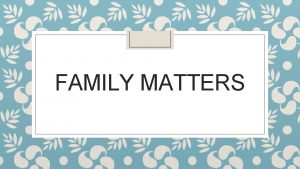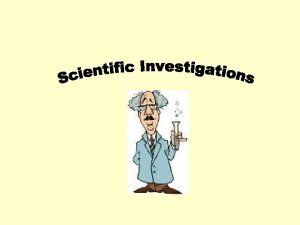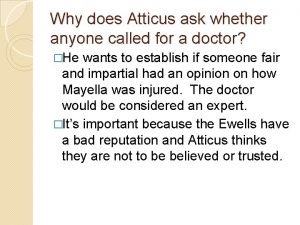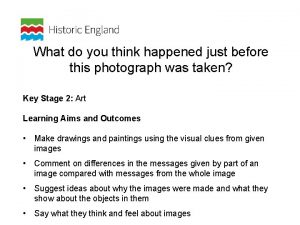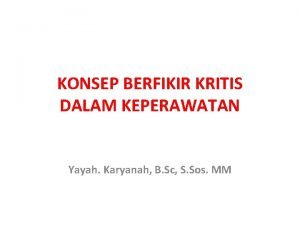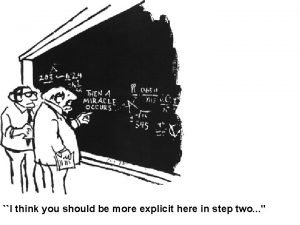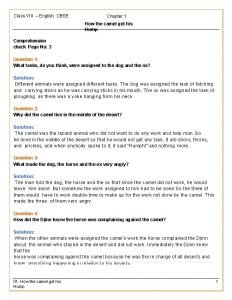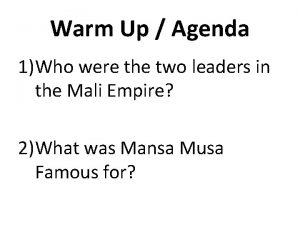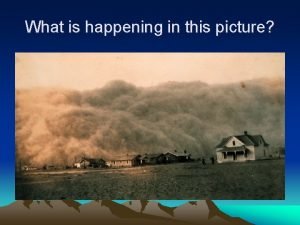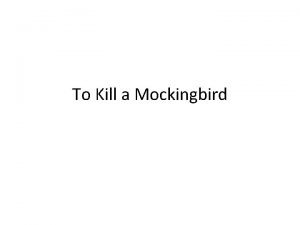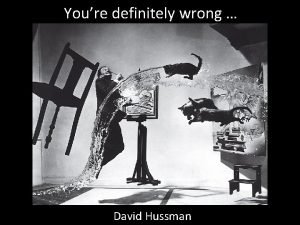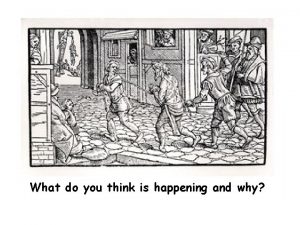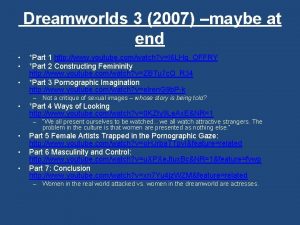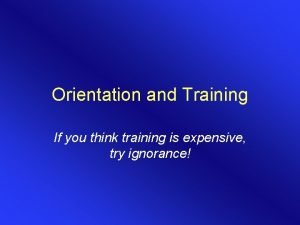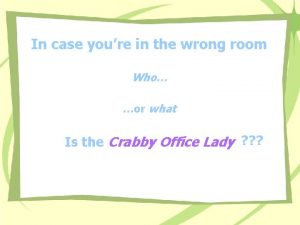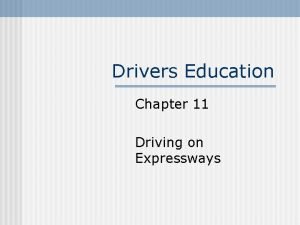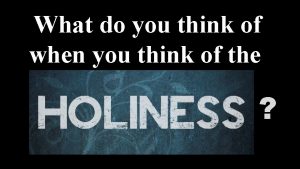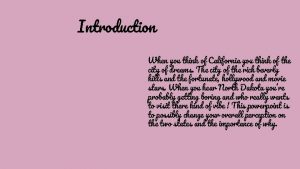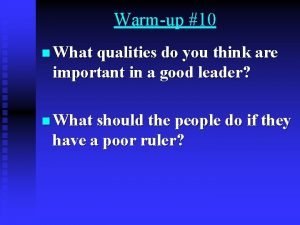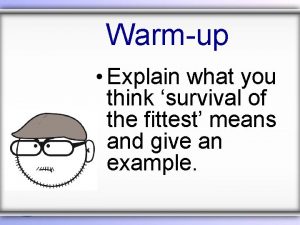Warmup What do you think of when you





























































































- Slides: 93

Warm-up What do you think of when you hear the word “deviant”?

Warm-up What do you think the difference between a deviance and a crime is?

Warm-up: In your opinion, in what ways does music have an effect on deviant behavior?

Debate Questions: • For or against first article • Agree/Disagree with rap music influence on deviant behavior


Vocabulary terms to define: • Deviance • Negative Deviance • Positive Deviance • Deviant • Social Control • Social Sanctions

Deviance and Social Control

• Groups, as we have seen, constantly try to enforce conformity on their members through the use of sanctions-both positive and negative; formal and informal. • In this section, we'll discuss how and why people deviate from social norms.

• Although tattoos and body piercings are relatively common, this was not always the case. – ~20 years ago, only bikers and other “socalled deviants” wore tattoos. No man would have pierced his ears without facing social stigma • Who do you think decides what and who is deviant? – Agreed upon by a consensus

The Nature of Deviance • The term deviance refers to behavior that departs from societal or group norms. • Actions or behaviors that violate social norms • It is difficult to define because not everyone agrees on what should be considered “deviant” behavior.

What do you consider deviant behavior?

What behavior was considered deviant when your parents were in high school, that is not considered deviant now?

Generally, "deviance" is regarded in a negative light, but there are many "positive" sides to deviance.

The Nature of Deviance (cont. ) • Negative deviance involves behavior that fails to meet accepted norms. • Positive deviance involves over conformity to norms, which leads to imbalance and extremes of perfectionism. • A deviant is a person who has violated one or more of society’s most highly valued norms.

A Show of Hands Is constantly washing your hands a positive or negative deviance? 1. Positive 2. Negative 3. Both 4. Neither http: //www. youtube. com/watch? v=ABCDPGzjal Q

Social Control • Without social control — ways to promote conformity to norms—social life would be unpredictable, even chaotic.

Social Control (cont. ) • Types of social control: – Internal social control lies within the individual; we know the difference between right and wrong due to the socialization process. – External social control is based on sanctions (formal and informal)—rewards or punishments designed to encourage desired behavior.

Social Control (cont. ) • Social sanctions are rewards or punishments designed to encourage desired behavior. • There are both positive and negative sanctions.

What are some examples of social control groups?

• Deviance is generally perceived to be disruptive in society. • It can weaken established social norms, and create division and disorder. • But, it also has other functions which are not necessarily harmful and may actually be beneficial to society.

Costs and Benefits of Deviance • Negative effects of deviance: – It erodes trust. – It can cause nonconforming behavior in others. – It is expensive.

Costs and Benefits of Deviance (cont. ) • Benefits of deviance: – It clarifies norms by exercising social control to defend its values. – It can be a temporary safety valve or relieve societal pressures. – It increases unity within a society or group. – It promotes needed social change.

Benefit-Social Change occurs • If a deviant act becomes more accepted it soon may be considered legitimate. – EX, many companies used to have dress codes-- (Managers were required to wear suits. In the early 1990 s more and more managers were showing up to work informally dressed. Soon, companies began to have "casual days. “ – Today, many American corporations have done away with the business suit altogether.

Helps people adjust to change • Deviance provides examples of alternate lifestyles and eases the shock of social change because "deviants" introduce these changes gradually. • Over time individuals get used to seeing different styles of dress, behavior, etc

Social Solidarity • Deviance has a way of promoting social solidarity by distinguishing "us" from "them. “ • In this way it increases social cohesion in the larger society by establishing social boundaries defining what is acceptable behavior. • Ex: Witch Trials in the 1600’s

Laws passed against witchcraft in New England in the 1600 s provide an example of how powerful people in the community were able to use deviance to their own advantage. Puritans strengthened the community's religious solidarity by blaming "witches" for the troubles the community was experiencing. Once these "witches" were identified, they were executed. Members of the community "closed ranks" and obeyed their religious leaders, least they be accused of witchcraft and be burned at the stake!

• Name things that people become addicted to • Do you consider people with these addictions to be deviant in behavior? • Does our society accept some addictive/obsessive behaviors?

Who are society’s deviants? To some extent, we all are. We break rules everyday.

Activity • Read “Murder among the Cheyenne” article, pg. 208 Answer these questions: • Do you think our society glorifies homicide? • Are there any examples in our society of similar banishments based on an individual’s deviant behavior?

Work on Chapter 7, Section 1 Assessment: Questions 1 -4

Section 2 Key Terms: • Anomie • Strain Theory • Control Theory

Activity- • Split into groups of 4 to 5 • Write a brief skit that illustrates deviant behavior in which you would see at AHS • Deviant behaviors should not be criminal • In the role play, you should portray not only the deviant behavior, but also the persons who consider the behavior to be deviant

Functionalism Strain Theory • Anomie is a social condition in which norms are weak, conflicting, or absent. • Strain theory is most likely to occur when there is a gap between culturally desirable goals, such as money and prestige, and a legitimate way of obtaining them. • Conformity is when people accept the goal and the means to achieve it.

Functionalism Strain Theory (cont. ) • These four responses to strain are considered deviant even though they might display conformity: – Innovation—illegal means used to achieve success – Ritualism—success rejected, but legitimate means still used – Retreatism—both goals and means rejected – Rebellion—rejected goals and means, but a new set of goals and means formed


A Show of Hands Which of the following is the most widespread response to strain? 1. Innovation 2. Ritualism 3. Retreatism 4. Rebellion

Functionalism Control Theory • According to Travis Hirschi’s control theory, conformity to social norms depends on the presence of strong bonds between individuals and society. • The social bond has four basic components: – Attachment – Commitment – Involvement – Belief

Debate • In one U. S. city, marijuana can be purchased simply by walking into a store with a medical prescription. • Merton would call this “innovation” because the goal of success is achieved using illegal means (assuming the buyer doesn’t actually need it for medical purposes) • Does legalization serve as a deterrent to crime?

Work on Chapter 7, Section 2 Assessment: Questions 1 -5

Symbolic Interactionism Differential Association Theory • Differential association theory emphasizes the role of primary groups in transmitting deviance. differential association theory that individuals learn deviance in proportion to the number of deviant acts they are exposed to

Symbolic Interactionism Differential Association Theory (cont. ) • Three characteristics affect differential association: – A person who spends considerable time with deviants is more likely to learn deviant behavior. – A person is more likely to copy deviant behavior from a significant other than from people less important to him or her. – Younger children learn deviant behavior more quickly than older children.

A Show of Hands Which characteristic do you think is most responsible for deviant behavior? 1. The ration of deviant to nondeviant individuals 2. Whether the deviant behavior is practiced by significant others 3. The age of exposure

Symbolic Interactionism Labeling Theory • Labeling theory explains why deviance is relative. Sometimes, if two people break the same norm, only one may be labeled a deviant. • Deviant behaviors are always a matter of social definition; they are relative.

Symbolic Interactionism Labeling Theory (cont. ) • Primary deviance is when a person engages only in isolated acts of deviance. • Secondary deviance refers to deviance as a lifestyle and as a personal identity.

Symbolic Interactionism Labeling Theory (cont. ) • Labeling has negative effects: – Stigma—an undesirable characteristic or label used by others to deny the deviant full social acceptance.

Crimes

Warm-up: Do you think you are capable of ever committing a crime? Why or why not?

Curiosity: How Evil Are You? • In this video, Roth plans to unveil the most horrifying monster of them all, capable of callous murder with only the slightest prodding: the Average American. • Roth and a team of psychological experts carry out a series of startling experiments that will shed light on the capacity for evil that lurks within ordinary men and women -- what they find will astound you

http: //www. youtube. com/watch? v=ovq 5 OUEggk&feature=youtu. be Clear your desks, only paper and something to write with. Write down 3 things you find the most interesting.

Milgram Experiment • Many war-criminals claimed they were merely following orders and could not be held responsible for their actions, in the trials following the World War II. • Were the Germans in fact evil and coldhearted, or is this a group phenomenon which could happen to anyone, given the right conditions?

Warm-up: Do you think there are inequalities in our justice system? How so?

Activity: • Read the following quote in groups of THREE (3) • Discuss what the author meant by this statement • How does it relate to conflict theory and deviance? • Do you see a connection? • Be prepared to share with the class.

Quote: “Since I cannot remain sane without the sense of “I”, I am driven to do almost anything to acquire this sense. Behind the intense passion for status and conformity is this very need…people are willing to risk their lives, to give up their love, to surrender their freedom, to sacrifice their own thoughts for the sake of being one of the herd, of conforming, and thus of acquiring a sense of identity, even though it is an illusory one” – Erich Fromm, The Sane Society.

Activity: • Read the following quote in groups of THREE (3) • Discuss what the author meant by this statement • How does it relate to conflict theory and deviance? • Do you see a connection? • Be prepared to share with the class.

Conflict Theory Deviance in Industrial Society • From the conflict perspective, deviance in an industrial society is behavior that those in control see as threatening to their interests.

Conflict Theory Deviance in Industrial Society (cont. ) • The following are considered deviants in an industrial society: – Critics of an industrial society. – Those who will not work. – Those who threaten private property. – Those who show a lack of respect for authority.

Conflict Theory Deviance in Industrial Society (cont. ) • The following is encouraged: – Certain activities, such as violence in sports, depending on how well they fit within the industrial society. – http: //www. cleanvid eosearch. com/medi a/action/yt/watch? vi deo. Id=7 LHh. L 2 e 61 J E

There was a study… • where 4 black male college students were sent to a suburban neighborhood and were told to drive around the neighborhood all night • 4 white male college students did the same thing in the same neighborhood • The black men were stopped 4 times by the police, while the white men were not stopped at all.

Question: • Why did the police make it a point to stop the black males and not the white males?

A Show of Hands Do you think a suspect’s race is likely to have an impact on their treatment in the criminal justice system? 1. Yes 2. No 3. Not sure • http: //www. cleanvideosearch. com/me dia/action/yt/watch? video. Id=Opb. NUP r. F 6 II

Conflict Theory Race, Ethnicity, and Crime • Supporters of the conflict perspective believe that minorities receive unequal treatment in the American criminal justice system. • Reasons for unequal treatment: – Minorities generally do not have the economic resources to buy good legal advice. – Crimes against whites tend to be punished more severely than crimes against minorities.

Conflict Theory Race, Ethnicity, and Crime (cont. ) • Victim discounting is the process of reducing the seriousness of the crimes that injure people of lower status. • SO-if the victim is less valuable, the crime is less serious, and the penalty is less severe.

Conflict Theory White-Collar Crime • White-collar crime is any crime committed by respectable and high-status people in the course of their occupations. • These people tend to be treated more leniently than other criminals. • Any famous examples? ? • http: //www. cleanvideosearch. com/media/a ction/yt/watch? video. Id=a 00 b. IV 8 e. Nx. Q

Article • Read New York Times Article, and write a 2 page essay about your thoughts on racial profiling. • Do you think in this instance, it can help prevent crimes? • Will one ever NOT hold prejudices or biases among certain racial groups? • Be sure to include examples.

Warm-up: How much do you think the media has to do with the way you think about crime? For example: The media talks more about murder and rape than any other crime, but surprisingly, murder and rape accounts for only 1% of the types of crimes committed by Americans.

Measurement of Crime – About two-thirds of crimes are not reported at all. – Crime reporting varies, and whitecollar offenders are seldom included.

Activity: • Different types of crimes include – Homicide, rape, robbery, & aggravated assault 1. In your notes, list 5 specific kinds of crimes (i. e. grand theft) 2. Classify the severity of each. 3. What kind of punishment would you assign for each crime?

Approaches to Crime Control • The criminal justice system is made up of the institutions and processes responsible for enforcing criminal statutes. • Police, courts, and the correctional system comprise the criminal justice system.

Approaches to Crime Control (cont. ) • Deterrence—threat of punishment used to discourage criminal actions. • Deterrence works if the lawbreakers know: – they are likely to get caught – the punishment will be severe

Approaches to Crime Control (cont. ) • Retribution—a type of punishment intended to make criminals pay compensation for their acts. • Incarceration—keeping criminals in prisons. • Rehabilitation—an approach to crime control that attempts to resocialize criminals. • However, there is a high rate of recidivism, or a repetition of or return to criminal behavior.

Approaches to Crime Control (cont. ) • Reasons for recidivism: – The basic nature of the offender – Influences of more hardened criminals – The stigma of being an ex-convict

Approaches to Crime Control (cont. ) • Some alternatives to rehabilitation in prisons: – A combination of prison and probation, or shock probation – Community-based programs – Diversion strategy

A Show of Hands Which approach to crime control do you think is most effective? 1. Deterrence 2. Retribution 3. Incarceration 4. Rehabilitation

Read & write down your reactions: Between the years of 1985 & 1997, the number of prison inmates under the age of 18 almost doubled. More states are now allowing people under the age of 18 to be tried as adults, depending on the type of crime committed. The thinking behind this trend is that if states take away a youth’s minor status, and they are tried as adults, they will be more accountable for the crime committed. Gang and drug related violence, along with an increase in school shootings over the past 10 years, has caused state law makers to favor adult prison terms for violent juvenile offenders. Currently, there are over 10, 000 juveniles in adult prisons. The adult prison population is about 1. 3 million.

Question: • What is the difference between deviance and evil? • Deviance: straying from what is “normal” • Evil: morally bad; profoundly immoral or wrong • How are these two terms connected?

Some Faces of Evil:

“Bloody Mary” Hannibal Lecter


Lizzie Borden, 32, was accused of murdering her father and stepmother in 1892 -- both were killed by hatchet blows to the head. Some speculate that she killed them because of property disputes, while others say she committed the murders while in a blacked-out state.

Pol Pot prime minister of Cambodia. He forced city residents to relocate to labor projects in the country, where about 2 million Cambodians died -that was about a third of the entire population. Some died of disease and starvation, while others were tortured and executed.

A symbol of evil to "Star Wars" fans everywhere, Emperor Palpatine was determined to destroy the Republic and the Jedi Knights to instill an authoritarian regime. Palpatine has another, much more fearsome identity: that of Darth Sidious, a Dark Lord of the Sith.

Countess Elizabeth Bathory, also known as "The Bloody Countess, " tortured, mutilated and killed hundreds of young peasant women over a period of 25 years. She was even accused of bathing in the blood of young virgins in an effort to maintain her own youthful appearance.

Ivan the Terrible was responsible for his army torturing and killing thousands of citizens of Novgorod TED BUNDY: a kidnapper, rapist and murderer, confessed to killing at least 30 young women

Michael Myers Jack the Ripper

Ilse Koch, sometimes known as "The B**** of Buchenwald, " was a Nazi married to Karl Koch, commandant of the concentration camps Buchenwald during World War II. Ilse was especially cruel to prisoners and was known for taking "souvenirs" from them when they were killed -- she would cut off and keep their tattoos, and she was also accused of making lampshades from human skin. She was arrested several times and eventually committed suicide in a women's prison in 1967.

Charles Manson V A M P I R E S

Albert Fish is known for being one of the most vile pedophiles and killers of all time. After his capture he admitted to molesting over 400 children and tortured and killed several others. He was eventually executed and according to rumors, he turned his own execution into a fantasy of pleasure

13 examples of everyday evil: 1) Anonymously emailing death threats. 2) Suing someone who did nothing wrong in order to try to collect a big payday. 3) Passing on information that you know is a lie about a political opponent. 4) Being an online troll. 5) Trying to convince people to do something that's immoral, unethical, or just plain old wrong so that you'll feel better about doing it yourself. . 6) Spraying graffiti on someone else's property. 7) Watching someone drop money on the ground and keeping it instead of giving it back to him. 8) Hacking into someone else's computer. 9) Choosing not to help pay for your own children's livelihood. 10) Spreading malicious rumors about friends and co-workers. 11) Aborting your child because it's inconvenient. 12) Writing a virus that infects someone's computer. 13) Knowingly accusing an innocent person of something.

Deviance and Evil: • Demonological Perspective: those that suggest that deviance and/or crime are the result of individuals’ possession by evil spirits and/or their temptation from the devil. • Throughout history, demonological perspectives have served as a nonscientific means of understanding events or behaviors that appear to be irrational (i. e. , murder)

Ex. of Demonological Perspective • Exorcisms • They are the typical response to what appears to be the work of demons • There are several historical and contemporary examples from real life exorcisms (and not just the stuff of Hollywood).

Anneliese Michel woman from Germany who claimed that she was possesed by demons. She was raised in Chatolic family. She noticed first signs of demonic possesion when she was 16. She started to get epileptic attacks and then some hallucinations too. After the regular medicine methods were not showing any results, she was treated by local bishop exorcist who used Catholic methods in order to cure her from possesion.

Anneliese Michel Unfortunately, those sessions weren’t so successful and she died when she was 23 while sleeping. The official cause of death is believed to be malnutrition and dehydration because she started to refuse food months before her death.

Discussion: • What are your thoughts on this perspective on deviance? • Why do you think demonological perspectives have been so prevalent throughout history? • Do you think people truly believed in the perspective, or was there more to it (for example: if people feared they themselves would become deviant, they wanted to believe that it was because of something they couldn’t control… in this case, the possession of demons)? • Do you think we will see demonological perspectives as frequently in the future? Why or why not?
 Think big think fast think ahead
Think big think fast think ahead Warmup ratio
Warmup ratio Warmup 65
Warmup 65 Gmass warmup
Gmass warmup Status vs class
Status vs class Surface area warm up
Surface area warm up Identical rhyme examples
Identical rhyme examples Exponent multiplication
Exponent multiplication Java warmup
Java warmup Define:warmup
Define:warmup Pathos story
Pathos story Tinman schwartz
Tinman schwartz Warmup 65
Warmup 65 Warmup end
Warmup end If you think you can you can poem
If you think you can you can poem Robin and jay poem
Robin and jay poem Think family ni
Think family ni So you think you can argue
So you think you can argue Choose the correct answers a-c how do you think you
Choose the correct answers a-c how do you think you Alan and susie an argument
Alan and susie an argument So you think you know minecraft
So you think you know minecraft Perceive family words
Perceive family words You have more potential than you think
You have more potential than you think What do you think of when you hear the word science
What do you think of when you hear the word science What do you think of when you hear
What do you think of when you hear You can argue
You can argue What is the lie atticus talks about
What is the lie atticus talks about Density mass volume
Density mass volume What do you think has just happened in these photos
What do you think has just happened in these photos What do you think the people are doing in the picture
What do you think the people are doing in the picture Think before you dig
Think before you dig Questions to ask about the cask of amontillado
Questions to ask about the cask of amontillado Main idea 2 being a clown answer key
Main idea 2 being a clown answer key What do you think the text is about?
What do you think the text is about? Rules of netiquette in ict
Rules of netiquette in ict Oh the thinks you can think quotes
Oh the thinks you can think quotes What is meant by the term people in media
What is meant by the term people in media A tree falls the way it leans quote meaning
A tree falls the way it leans quote meaning Elemen berpikir kritis dalam keperawatan
Elemen berpikir kritis dalam keperawatan I think you should be more explicit here in step two
I think you should be more explicit here in step two Think before you lift
Think before you lift God is closer than you think
God is closer than you think Describe how dog horse and ox turned against the man
Describe how dog horse and ox turned against the man Mexicano contributions
Mexicano contributions What do you think is happening in this picture?
What do you think is happening in this picture? What comes to your mind when you think about god
What comes to your mind when you think about god What do you think was askia's greatest accomplishment?
What do you think was askia's greatest accomplishment? What does kat fear will happen if she wins
What does kat fear will happen if she wins Why do you think has grete's attitude toward gregor changed
Why do you think has grete's attitude toward gregor changed Work in pairs. discuss the questions
Work in pairs. discuss the questions I owe you an apologize
I owe you an apologize Plant layout concepts
Plant layout concepts Do you think jackson’s indian policy promoted democracy
Do you think jackson’s indian policy promoted democracy Work in pairs discuss what is common
Work in pairs discuss what is common Work in pairs and answer the following questions
Work in pairs and answer the following questions What do you think is happening in this picture
What do you think is happening in this picture What happened in this picture
What happened in this picture This image represents the along with its
This image represents the along with its Think back when you are in grade 1
Think back when you are in grade 1 What did you do last night answer
What did you do last night answer What do you think of the way atticus treats walter
What do you think of the way atticus treats walter Yep, she is who you think
Yep, she is who you think He died for me
He died for me What do you think about vietnam idol shows
What do you think about vietnam idol shows What do you think causes grendel to attack human beings?
What do you think causes grendel to attack human beings? I all of the questions correctly since
I all of the questions correctly since I think what you did was wrong david
I think what you did was wrong david The baretop trickster
The baretop trickster Think before you spit
Think before you spit Luke 13 3 5
Luke 13 3 5 You must think over the problem carefully
You must think over the problem carefully It always takes longer than you think
It always takes longer than you think What is the theme of the fox and the goat
What is the theme of the fox and the goat Did you ever think
Did you ever think Did you ever think
Did you ever think What is involved in the process of exchanging messages
What is involved in the process of exchanging messages What do you think makes a good friend
What do you think makes a good friend What do you think of the topic
What do you think of the topic 1 corinthians 13:8
1 corinthians 13:8 What do you think about mr. deni?
What do you think about mr. deni? What do you think about mr. deni
What do you think about mr. deni If you think training is expensive try ignorance
If you think training is expensive try ignorance You're in the wrong room
You're in the wrong room Why do junior and rowdy climb the tree
Why do junior and rowdy climb the tree Think before you print
Think before you print Drive in the right lane on expressways to avoid conflicts
Drive in the right lane on expressways to avoid conflicts The necklace anticipation guide
The necklace anticipation guide Rain
Rain You are what you eat do you agree or disagree
You are what you eat do you agree or disagree Tell me what you eat and i shall tell you what you are
Tell me what you eat and i shall tell you what you are I will follow you follow you wherever you may go
I will follow you follow you wherever you may go Animal acrostic poem
Animal acrostic poem Think pair share example
Think pair share example Uster think quality
Uster think quality





















